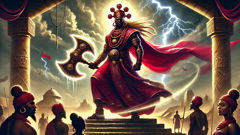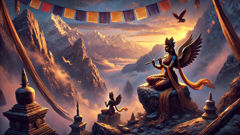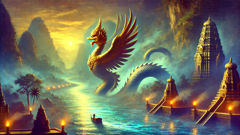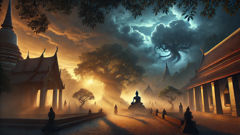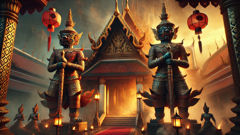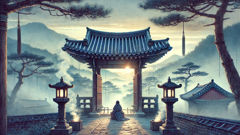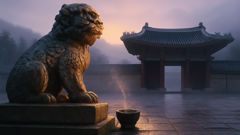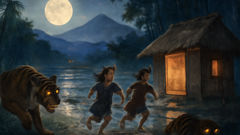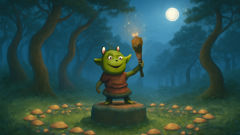Introduction
The savannahs and forests of ancient West Africa whispered with stories long before any scribe set ink to parchment. In the heart of this land, the Oyo Empire rose, mighty and influential, its palaces gleaming beneath the sun, its markets alive with music and trade. Among the kings who ruled from the palace of Oyo-Ile, none cast a longer shadow or left a more enduring legacy than Shango, the fourth Alaafin. His was a name carried on the thunder, a legend etched in the memory of a people. From his youth, Shango was marked by a ferocious ambition and a spirit like the harmattan wind—unpredictable, fierce, and vital. He was a warrior whose laughter rang out on the battlefield, a lover whose passions burned as hot as his rage, and a leader whose choices changed the very fate of the empire. But Shango was more than a king. In time, his story would break the boundary between man and god, for destiny had set a path before him that led beyond thrones and into the realm of the Orisha—the deities who shaped the world. To understand the legend of Shango is to witness the collision of human flaw and supernatural power, of loyalty and betrayal, of the storm within and the storm without. His tale is one of courage tested, hearts broken, alliances forged and sundered, and a transformation so profound that to this day, when the skies tremble and fire dances across the clouds, the Yoruba say it is Shango, their thunder king, speaking once again. This is the epic of Shango—his rise, his fall, and his ascension into immortality.
The Rise of a King: Shango’s Early Life and Path to Power
Long before he became legend, Shango was a child of destiny. Born to Oranmiyan—the founder of Oyo and himself a figure shrouded in myth—Shango grew up amidst palace intrigue and the ever-present rumble of drums that marked the empire’s pulse. His mother, Torosi, was renowned for her wisdom, and from her Shango learned to read the language of omens and to respect the spirits that moved unseen through the world. But it was his father’s blood that blazed in his veins: restless, commanding, ever hungry for greatness.
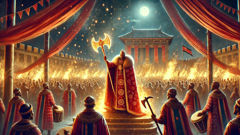
As a youth, Shango was marked by an unyielding vigor and a hot temper that sometimes bordered on reckless. He excelled in the arts of war—his spearwork was unmatched, and his laughter could be heard over the clangor of battle as he led hunting parties deep into the forests. Among his brothers, Shango stood out, both admired and feared. He was known for his love of the drum and the dance, for nights spent in the flicker of firelight, weaving stories and challenging fate. Even then, rumors spread that he possessed a touch of the supernatural—that storms seemed to follow in his wake, that fire sometimes answered to his call.
When Oranmiyan departed to found new realms, the people of Oyo found themselves divided. Rival clans vied for influence, and the palace halls grew thick with conspiracies. It was in this climate that Shango’s leadership was forged. One tale tells of a night when marauders from the Nupe crossed the river in a surprise attack. As panic gripped the city, Shango rallied warriors and commoners alike. With his double-headed axe flashing in the moonlight, he cut through the invaders, his voice rising above the din like rolling thunder. By dawn, the city was saved, and Shango’s name had become a song on every tongue.
His ascension to the throne was not unchallenged. Shango’s half-brothers, Ajaka and Dada, each claimed the right to rule, and their supporters sought to turn the tide against him. The palace became a place of whispered threats and poisoned cups. Shango’s sense of justice, however, was as fierce as his temper. He confronted his rivals not with subterfuge, but with public debate and, when needed, a warrior’s might. It was said that when he spoke, his words cracked like thunderbolts, scattering all doubt. In time, both brothers were exiled—Ajaka to the forests, Dada to distant lands—and Shango was crowned Alaafin, king of Oyo, beneath the gaze of elders and ancestors.
The coronation was a spectacle—flames leapt skyward as drums thundered and dancers spun in wild circles. Shango wore crimson robes embroidered with lightning, and his crown shone with obsidian stones. The people saw in him the promise of a new era—one shaped by courage, strength, and a touch of the divine. Yet even as he basked in triumph, shadows gathered at the edges of his reign. The gods watched, silent and inscrutable, as Shango began his journey from mortal king to immortal legend.
The Trials of Power: Rivalry, Betrayal, and the Unleashing of Storms
Shango’s early reign brought prosperity and pride to Oyo. Trade flourished, the arts blossomed, and warriors returned from campaigns with tales of victory. Yet peace is a fragile thing, and for every festival that echoed through Oyo-Ile’s streets, there were nights when trouble pressed at the kingdom’s edges.
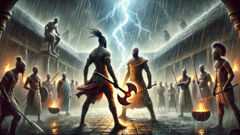
The greatest threat came not from distant foes but from within—Shango’s own court. His fierce rule bred resentment among powerful chiefs, who bristled at his uncompromising authority. The council, once loyal, grew wary as Shango’s justice cut through corruption like a lightning bolt. Chief Gbonka, a cunning tactician and former friend, felt his influence wane as Shango demanded loyalty above all else. Even Oba Timi, ruler of the nearby city of Ede and an erstwhile ally, nursed ambitions that would soon ignite like dry grass in harmattan.
Whispers spread: Shango was growing too powerful, perhaps even dangerous. It was said that he kept secret rites in the depths of his palace, that he communed with the Orisha and called storms with his voice. The more he tried to assert order, the more some plotted his fall. Shango’s wives—Oya, Oba, and Osun—became pawns in these rivalries, their hearts caught between loyalty and fear for the king’s safety. Oya, especially, matched Shango’s fire with her own—her courage and passion made her his fiercest defender and closest confidant.
A series of omens foretold the coming storm: a flock of birds scattering at midday, lightning splitting a baobab tree during a dry season, and dreams that left the king shivering in his sleep. Shango’s own power began to manifest in strange ways. During a council meeting marred by heated debate, thunder cracked overhead without a cloud in the sky. On another night, when assassins crept into the palace gardens, they were found charred and lifeless, as if struck down by fire from above. These miracles won Shango awe but also fear—some wondered if he was still wholly mortal.
Gbonka, feeling cornered, conspired with Oba Timi to undermine Shango’s rule. They rallied warriors and spread rumors that Shango’s magic threatened to doom the empire. A rebellion brewed, pitting brother against brother, friend against friend. When open conflict erupted, the city shook with violence. Oya rode into battle at Shango’s side, her hair whipping like a banner as she summoned winds to blind their enemies. Osun brought healing to the wounded, and Oba’s wisdom helped rally loyal clans.
At the height of the fighting, Gbonka challenged Shango to a duel. It was a spectacle for the ages: two giants of Oyo circling each other as rain began to fall in sheets. The earth shook with each blow of their weapons. As Gbonka lunged, Shango’s axe blazed with unnatural light; lightning arced from the heavens and struck his foe down. The rebels scattered, awed by the king’s terrifying might. Yet the victory came at a cost. The city’s walls were scarred, trust was frayed, and whispers grew that Shango was no longer a man but something else—a force of nature.
Exhausted by betrayal and wracked with doubt, Shango withdrew from the palace. Nights found him wandering alone beneath storm-laden skies, seeking answers from the ancestors and Orisha. The line between king and god was beginning to blur, and Shango sensed that his greatest trial was yet to come.
The Fall and Ascension: Tragedy, Sacrifice, and Becoming an Orisha
Peace after the rebellion proved elusive. Though Shango had crushed his rivals, the cost in blood and trust weighed heavily on the city. The council grew silent, and even the laughter in the palace seemed dimmer. Shango’s wives sensed his growing isolation; Oya tried to reach him with fierce affection, but his gaze often drifted to the horizon. The people revered him as king, but fear crept into their praise. It was said that the spirits themselves walked with Shango now, and that storms would answer when he called.
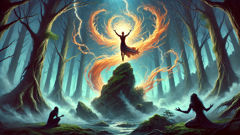
Burdened by guilt and suspicion, Shango sought to prove his worth to his people. He journeyed to the sacred grove of Koso—a place where the boundary between worlds grew thin. There, he fasted and performed rites to commune with the Orisha. Visions came to him: fire leaping from his tongue, thunder roaring at his command, and distant lands trembling beneath his steps. But with the visions came warnings—the line between power and destruction was dangerously thin.
Word reached Shango that remnants of his enemies had regrouped, this time supported by rival cities eager to topple the thunder king. In a final bid to save his throne and prove his divinity, Shango called forth a storm greater than any Oyo had seen. The skies darkened; wind lashed the city; lightning struck the earth with a fury that set trees ablaze and split stone. In the chaos, even his loyal followers grew terrified. The storm raged beyond Shango’s control—houses burned, and innocent lives were lost. The people, once awed by their king’s might, now pleaded for mercy.
Realizing the devastation he had wrought, Shango was overcome with grief. He saw that power without wisdom leads only to ruin. Guided by a vision of his ancestors and the voice of Oya—who urged him to seek redemption rather than destruction—Shango made a fateful choice. He would lay down his crown and accept exile to save his people from further suffering. With heavy heart, he left Oyo behind, journeying deep into the forests, accompanied only by Oya and a handful of faithful.
In the depths of Koso, Shango prepared for a final rite. He called out to the Orisha, seeking forgiveness and transformation. Legend says he danced atop a sacred stone as thunderclouds gathered overhead; lightning crowned him as fire swirled at his feet. In a blinding flash, Shango vanished—his mortal body gone, but his spirit ascending. Oya wept for her beloved but knew that his sacrifice would become legend.
News of Shango’s disappearance spread through Oyo like wildfire. Some claimed to see him in the storm clouds; others heard his laughter in the thunder. With time, the people began to venerate Shango not as a king who failed but as an Orisha who had transcended—protector of justice, bringer of rain and fire, patron of warriors and drummers. Rituals grew around his memory: dances imitating his battles, prayers seeking his strength, and offerings left at shrines whenever lightning split the sky.
Thus did Shango’s story cross the border from history into myth. His courage, flaws, and sacrifice became a lesson etched into the heart of Yoruba culture—a reminder that true greatness is not measured by power alone, but by the wisdom to wield it well and the humility to accept one’s limits.
Conclusion
In the centuries that followed, Shango’s legend grew far beyond the walls of ancient Oyo. His story became a living force—carried in drumming rhythms, echoed in thunder, and honored in festivals where devotees dressed in red would whirl and leap, invoking his presence. The Orisha of thunder is more than just a god of storms: he embodies the courage to lead, the danger of unchecked power, and the possibility of transformation through sacrifice. Shango’s journey from flawed king to immortal protector remains central to Yoruba identity and spiritual practice, a beacon for all who face trials of strength and character. Even today, when rain pelts rooftops and lightning arcs across the sky, his tale endures—a reminder that within every storm lies not only destruction but also renewal and hope.

